Related Research Articles
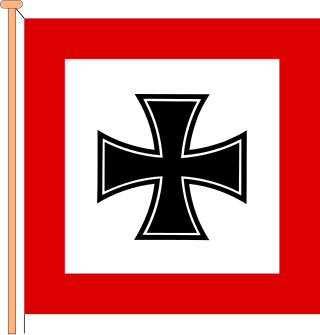
The Oberkommando des Heeres was the high command of the Army of Nazi Germany. It was founded in 1935 as part of Adolf Hitler's rearmament of Germany. OKH was de facto the most important unit within the German war planning until the defeat at Moscow in December 1941.
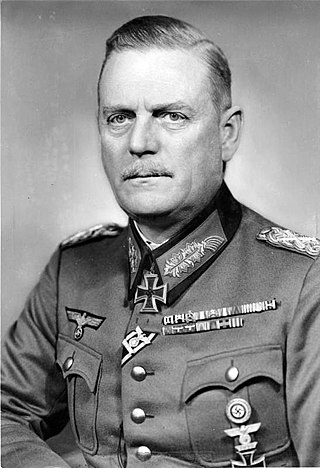
Wilhelm Bodewin Johann Gustav Keitel was a German field marshal and convicted war criminal who held office as chief of the Oberkommando der Wehrmacht (OKW), the high command of Nazi Germany's armed forces, for most of World War II. In that capacity, Keitel was Germany's de facto war minister. He signed a number of criminal orders and directives that led to numerous war crimes.
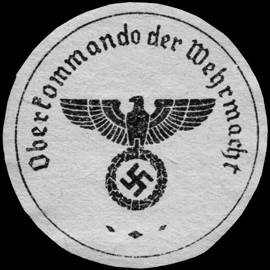
The Oberkommando der Wehrmacht was the high command of the armed forces of Nazi Germany. Created in 1938, the OKW replaced the Reich War Ministry and had oversight over the individual high commands of the country's armed forces: the army, navy, and air force.

The Afrika Korps or German Africa Corps was the German expeditionary force in Africa during the North African campaign of World War II. First sent as a holding force to shore up the Italian defense of its African colonies, the formation fought on in Africa, under various appellations, from March 1941 until its surrender in May 1943. The unit's best known commander was Field Marshal Erwin Rommel.
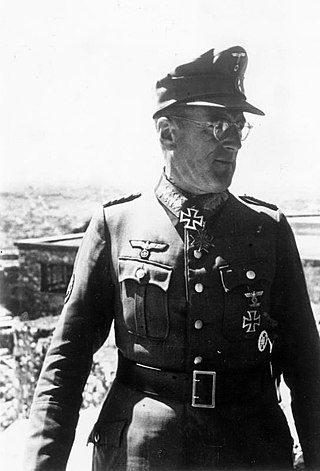
Ferdinand Schörner was a German military commander who held the rank of Generalfeldmarschall in the Wehrmacht of Nazi Germany during World War II. He commanded several army groups and was the last Commander-in-chief of the German Army.
TICOM was a secret Allied project formed in World War II to find and seize German intelligence assets, particularly in the field of cryptology and signals intelligence.

Fritz Erich Fellgiebel was a German Army general of signals and resistance fighter in the 20 July plot to assassinate Nazi dictator Adolf Hitler. In 1929, Fellgiebel became head of the cipher bureau of the Ministry of the Reichswehr, which would later become the OKW/Chi. He was a signals specialist and was instrumental in introducing a common enciphering machine, the Enigma machine. However, he was unsuccessful in promoting a single cipher agency to coordinate all operations, as was demanded by OKW/Chi and was still blocked by Joachim von Ribbentrop, Heinrich Himmler and Hermann Göring until autumn 1943. It was not achieved until General Albert Praun took over the post.

Karl Stein was a German mathematician. He is well known for complex analysis and cryptography. Stein manifolds and Stein factorization are named after him.
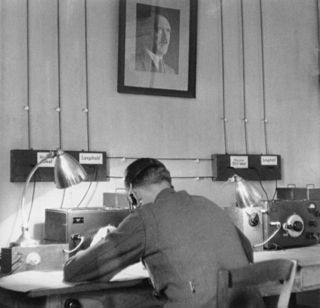
The Abwehr was the German military-intelligence service for the Reichswehr and the Wehrmacht from 1920 to 1945. Although the 1919 Treaty of Versailles prohibited the Weimar Republic from establishing an intelligence organization of their own, they formed an espionage group in 1920 within the Ministry of Defence, calling it the Abwehr. The initial purpose of the Abwehr was defence against foreign espionage: an organizational role which later evolved considerably. Under General Kurt von Schleicher the individual military services' intelligence units were combined and, in 1929, centralized under Schleicher's Ministeramt within the Ministry of Defence, forming the foundation for the more commonly understood manifestation of the Abwehr.
The Cipher Department of the High Command of the Wehrmacht was the Signal Intelligence Agency of the Supreme Command of the Armed Forces of the German Armed Forces before and during World War II. OKW/Chi, within the formal order of battle hierarchy OKW/WFsT/Ag WNV/Chi, dealt with the cryptanalysis and deciphering of enemy and neutral states' message traffic and security control of its own key processes and machinery, such as the rotor cipher machine ENIGMA machine. It was the successor to the former Chi bureau of the Reichswehr Ministry.
The Research Office of the Reich Air Ministry was the signals intelligence and cryptanalytic agency of the German Nazi Party from 1933 to 1945. Run since its inception by Luftwaffe chief Hermann Göring, the Research Bureau was a Nazi Party institution rather than an official Wehrmacht-run military signals intelligence and cryptographic agency.
The Pers Z S was the signals intelligence agency of the German Foreign Office before and during World War II. It consisted of two cryptologic sections. Pers Z S was the cryptanalytic section which was called Special Service of Z Branch of the Foreign Office Personnel Department. Its mission was the solution of foreign diplomatic codes and ciphers. The other section, which was the Cryptography Section was called Personal Z Cipher Service of the Federal Foreign Office. The latter section was responsible for compilation, distribution and security of Foreign Office codes and ciphers. Both were colloquially known as Pers Z S. Though similar in nature and operation to the OKW/Chi cipher bureau, it was a civilian operation as opposed to the military operation at OKW/Chi and focused primarily on diplomatic communications. According to TICOM interrogators it evinced an extraordinary degree of competence, primarily driven by a consistency of development not found in any other German signals bureau of the period. Pers Z S/Chi was the symbol and the code name of the Chiffrierdienst, i.e. the Cryptanalysis Department of Pers Z S. Although little is known about the organization, in the final analysis, Pers Z S labored at diplomatic cryptanalysis for a regime for which there were no diplomatic solutions.

Wilhelm Fenner was a German cryptanalyst, before and during the time of World War II in the OKW/Chi, the Cipher Department of the High Command of the Wehrmacht, working within the main cryptanalysis group, and entrusted with deciphering enemy message traffic (Cryptography). Wilhelm Fenner was considered an excellent organizer, an anti-Nazi, an anti-Bolshevik and a confirmed Protestant and was known by colleagues as someone who was keen to continue working in cryptology after World War II. To quote military historian David Alvarez:

Erich Hüttenhain was a German academic mathematician and cryptographer (Cryptography) and considered a leading cryptanalyst in the Third Reich. He was Head of the cryptanalysis unit at OKW/Chi, the Cipher Department of the High Command of the Wehrmacht.
Peter Novopashenny was before and during the World War I, a Russian Marine Officer and who worked as a cryptanalyst during World War II for the German Wehrmacht (OKW/Chi) cipher bureau, working on the Russian desk, deciphering enciphered Soviet communications.
General der Nachrichtenaufklärung was the signals intelligence agency of the Heer, before and during World War II. It was the successor to the former cipher bureau known as Inspectorate 7/VI in operation between 1940 and 1942, when it was further reorganised into the Headquarters for Signal Intelligence between 1942 and 1944, until it was finally reorganised in October 1944 into the GdNA. The agency was also known at the OKH/Gend Na, GendNa or Inspectorate 7 or more commonly OKH/GdNA. Inspectorate 7/VI was also known as In 7 or In/7 or In 7/VI and also OKH/Chi.
Ostwin Fritz Menzer was a German cryptologist, who before and during World War II, worked in the In 7/VI, the Wehrmacht signals intelligence agency, later working in that was the cipher bureau of the supreme command of the Nazi party, and later in Abwehr, the military intelligence service of the Wehrmacht. He was involved in the development and production of cryptographic devices and procedures, as well as the security control of their own methods.
Otto Buggisch was a German mathematician who, during World War II, was a cryptanalyst working in the cipher bureau, the Cipher Department of the High Command of the Wehrmacht (OKW/Chi) responsible for deciphering of the opposing forces Communications. He also dealt with the security control of own key procedures. Through research and revelations exposed by two Polish officers, late in the war, he recognized the true cryptographic weaknesses of the Enigma rotor cipher, key machine used by the German armed forces to encrypt their secret communications, in World War II.

Alexander Aigner was number theorist and a full university professor for mathematics at the Karl Franzens University in Graz, Austria. During World War II he was part of a group of five mathematicians, which was recruited by the military cryptanalyst Wilhelm Fenner, and which included Ernst Witt, Georg Aumann, Oswald Teichmueller and Johann Friedrich Schultze, to form the backbone of the new mathematical research department in the late 1930s, which would eventually be called Section IVc of Cipher Department of the High Command of the Wehrmacht.. The group was led by the German professor of mathematics Wolfgang Franz.
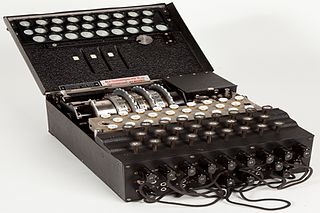
German Army cryptographic systems of World War II were based on the use of three types of cryptographic machines that were used to encrypt communications between units at the division level. These were the Enigma machine, the teleprinter cipher attachment, and the cipher teleprinter the Siemens and Halske T52,. All were considered insecure.
References
- ↑ David Kahn (5 December 1996). The Codebreakers: The Comprehensive History of Secret Communication from Ancient Times to the Internet. Simon and Schuster. p. 481. ISBN 978-1-4391-0355-5 . Retrieved 20 March 2021.
- ↑ Rezabek, Randy (3 April 2013). "TICOM and the Search for OKW/ Chi". Cryptologia. 37 (2): 139–153. doi:10.1080/01611194.2012.687430. S2CID 37039981.
- ↑ Jager, Benedikt (2019). Seehundspeck und Hundeschlitten: Alfred Otto Schwede als Übersetzer des skandinavischen Nordens. Skandinavistik--Sprache, Literatur, Kultur (in German). Vol. 13. LIT Verlag Münster. p. 29. ISBN 978-3-643-91189-6. OCLC 1197629264.